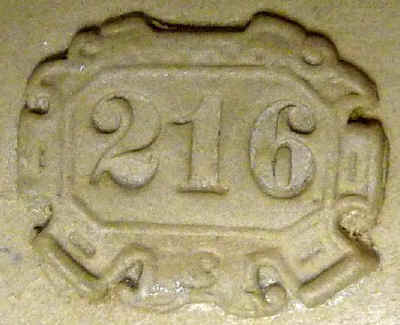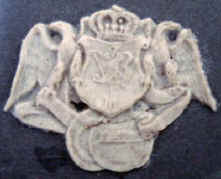
 |
 |
 Other versions that are larger and more detailed have the dates "1822" and "1844" visible and presumably for prizes won by Villeroy & Boch. Other
probably later versions of this stein have been seen with the form number "216"
as shown above (but no associated "M" for Mettlach) written or impressed, but the stein itself
has not appeared in any Mettlach catalog from 1885 or thereafter. This stein can be dated
from 1844 to early 1870's
on account of the early form number and because it has no capacity mark in liters. Germany did not adopt the metric
system until 1875 and therefore steins marked with capacities in liters will have been made after that date. Conversely
steins without capacity marks in liters were probably produced before 1875.
Other versions that are larger and more detailed have the dates "1822" and "1844" visible and presumably for prizes won by Villeroy & Boch. Other
probably later versions of this stein have been seen with the form number "216"
as shown above (but no associated "M" for Mettlach) written or impressed, but the stein itself
has not appeared in any Mettlach catalog from 1885 or thereafter. This stein can be dated
from 1844 to early 1870's
on account of the early form number and because it has no capacity mark in liters. Germany did not adopt the metric
system until 1875 and therefore steins marked with capacities in liters will have been made after that date. Conversely
steins without capacity marks in liters were probably produced before 1875.
Another interesting feature of this stein is the hexagram on the lid. Most would jump to the conclusion that this is the "Star of David" or "Seal of Solomon" and it would be if it were on a Kiddush Cup or an Israeli flag. However
 this ubiquitous hexagram symbol has appeared in many societies for millennia and is not the sole property of the
Jewish culture. When it's on a beer stein, it is referred to as the Brauerstern
(brewer's star) or when over the front
door to a tavern as a Zoigelstern (advertising star) meaning that beer is brewed and served at that location.
this ubiquitous hexagram symbol has appeared in many societies for millennia and is not the sole property of the
Jewish culture. When it's on a beer stein, it is referred to as the Brauerstern
(brewer's star) or when over the front
door to a tavern as a Zoigelstern (advertising star) meaning that beer is brewed and served at that location.
I believe that the brewer's star had its origin in the 1516 Rheinheits' Gebot (German brewing purity law) when it was decreed that beer should be made only from hops, barley and water. These three ingredients would make up the first triangle of the hexagram. There is another verse that appears in conjunction with beer steins that reads "Hopfen und Malz, Gott erhalts." (hops and malt, God controls). This would seem to indicate that God controls the growing and quality of the hops and barley and maybe even the brewing of beer. It was not known until Pasteur came along in the early 19th century and discovered yeast as the catalyst for brewing. So I suggest that the second interlocking triangle represents the Holy Trinity (and/or the unknown yeast) completing the hexagram.
This has been my version of the story of the Brauerstern. Joe Hersch presents another version in Character Steins - A Collector's Guide by E. V. Manusov and M. Wald. Both versions are speculations and cannot be proven. One is probably as good as another.